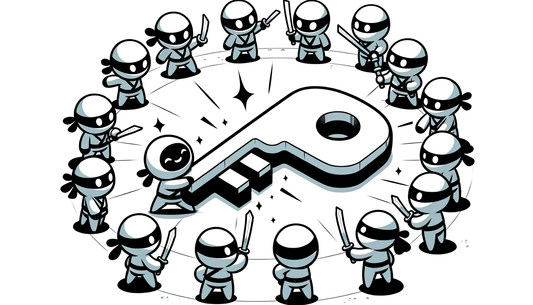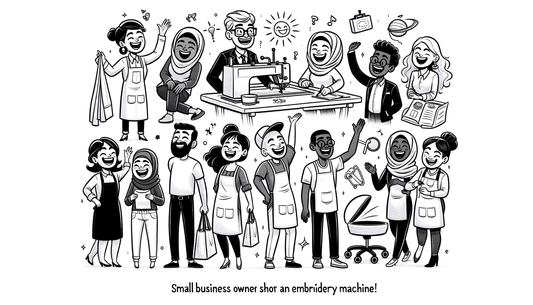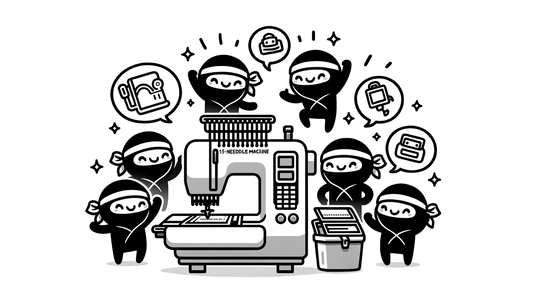
Choosing the Right Embroidery Stabilizer: A Comprehensive Guide
Share
Embroidery can transform ordinary fabric into stunning works of art, but achieving professional results requires more than just a great design and steady hand. One of the most crucial, yet often overlooked, elements is the embroidery stabilizer. Choosing the correct stabilizer can be the difference between a crisp, clean design and a puckered, distorted mess. This guide will walk you through the different types of embroidery stabilizers, their ideal uses, and common mistakes to avoid, ensuring your next embroidery project is a success.
Understanding Embroidery Stabilizers
Embroidery stabilizers provide essential support to fabric during the stitching process. They prevent stretching, puckering, and distortion, allowing your embroidery machine to create precise, high-quality designs. Different fabrics and projects require different types of stabilizers, each with its own unique properties and applications. Let's explore the three main types: cut-away, tear-away, and wash-away.
Types of Embroidery Stabilizers
Cut-Away Stabilizers: Permanent Support
Cut-away stabilizers are designed to be permanent, meaning they remain attached to the fabric after the embroidery is complete. Excess stabilizer is trimmed away, but a portion stays behind to provide ongoing support through laundering and wear. This type of stabilizer is ideal for:
- Stretchy or Knit Materials: Such as t-shirts, sweatshirts, and golf shirts.
- Garments Requiring Continued Stabilization: Preventing design distortion, especially after washing. Cut-away stabilizers prevent the dreaded "wadding up" effect that can ruin an embroidered design.
Cut-away stabilizers range from heavy-duty options like Cut-Away Plus™ to lighter versions like Soft ‘n Sheer™. Mesh cut-away stabilizers are also available for delicate fabrics, sheer materials, or loose-knit items. The mesh ensures invisibility through the fabric and provides added comfort. If you're looking to create professional-grade apparel that lasts, consider using a high-quality embroidery machine like the Embro Ninjas NinjaStarter, paired with the appropriate cut-away stabilizer, for exceptional results. Its precision and customizable options will allow you to create exactly what you're looking for!
Tear-Away Stabilizers: Temporary Support
Tear-away stabilizers are temporary and are removed by tearing them away after the stitching is complete. These stabilizers are best suited for:
- Sturdy Fabrics: Such as cotton, linen, towels, scarves, and woven materials.
- Projects Where Distortion and Puckering Need Prevention: But where ongoing support is not required.
Tear-away stabilizers are categorized by weight, with heavier options for heavy fabrics and lighter options for standard woven fabrics. Multiple layers can be used for extra stabilization, with each layer torn away individually. However, tear-away stabilizers are not recommended for delicate fabrics, as the tearing action can be too harsh and cause damage.
Wash-Away Stabilizers: Complete Removal
Wash-away stabilizers are also temporary but differ in that they completely dissolve in water after the embroidery is finished. These stabilizers are perfect for:
- Sheer Fabrics: Where any residue would be visible.
- Freestanding Lace: Where the stabilizer must be entirely removed to reveal the intricate design.
- Projects Where No Stabilizer Residue is Desired: Ensuring a clean and professional finish.
Wash-away stabilizers are especially helpful for delicate fabrics, as they eliminate the risk of damage associated with physical removal methods like tearing or cutting.
Fabric Compatibility Guidelines
Choosing the right stabilizer for your fabric is crucial. Here's a quick guide:
- Cut-Away Stabilizer: Use for stretchy or knit fabrics (t-shirts, sweatshirts, golf shirts) and mesh cut-away for sheer, delicate, or loose-knit fabrics. Avoid for silk and fabrics that require a temporary stabilizer.
- Tear-Away Stabilizer: Use for stable, sturdy fabrics (cotton, linen, towels, heavy wovens). Do not use on delicate or stretchy fabrics, as tearing can cause distortion or damage.
- Wash-Away Stabilizer: Use for sheer fabrics, freestanding lace, or projects requiring no remaining backing. Ideal for delicate fabrics where any form of physical removal is unsuitable.
Usage Tips for Different Projects
- Match the Stabilizer: Always match the stabilizer type and weight to the fabric type and stitch density.
- Consider Laundering: For garments or items subject to frequent laundering, prefer cut-away for lasting support.
- Easy Removal: For fast, easy removal and projects where the stabilizer should not stay, use tear-away for sturdy fabrics.
- Test First: Always test the stabilizer on scrap fabric to ensure compatibility and desired results before starting the main project.
- Layer Up: Use multiple layers of tear-away if more stabilization is needed; remove layers individually.
- Clean Back: For embroidery that requires a completely clean back, such as lace or delicate sheers, use wash-away stabilizer.
- Avoid Bulk: For sheer or lightweight fabrics, consider using mesh cut-away or wash-away stabilizers to avoid bulk and visibility issues.
To make sure you always use the right stabilizer, consider the customizable options for your embroidery machine. If you would like to see how your machine can be personalized to customer preferences, visit https://www.embroninjas.com/pages/customize-your-embroidery-machine.
Common Stabilizer Mistakes to Avoid
- Using tear-away stabilizer on stretchy or knit fabrics: This leads to design distortion after washing or wearing.
- Choosing the wrong stabilizer weight: Too light or too heavy can cause puckering or insufficient support.
- Tearing aggressively: Tearing away stabilizer too aggressively on delicate fabrics can cause fabric damage or distorted embroidery.
- Insufficient Layers: Using only one layer of tear-away when multiple layers are needed for dense designs or heavy fabrics.
- Skipping the Test: Not testing the stabilizer/fabric combination on a scrap piece can result in poor outcomes or fabric damage.
- Visible Residue: Using cut-away stabilizer where a clean back is needed (e.g., lace, sheers) results in visible or bulky residue.
- Forgetting to trim: Forgetting to trim excess cut-away stabilizer closely to the design can create irritation or show through the fabric.
Investing in a reliable embroidery machine like the NinjaStarter from Embro Ninjas ensures that you have the precision and control needed to work with various stabilizers and fabrics. With its advanced features and ease of use, you can confidently tackle any embroidery project. With factory-direct pricing you can be sure that you're getting exceptional value for your money. To hear about our company story or to emphasize trust and experience, follow the link: https://www.embroninjas.com/pages/about-us.
Best Practice
Always assess your project’s fabric, the complexity of the embroidery design, and the desired finish before selecting a stabilizer. When unsure, test with scraps to fine-tune the stabilizer type and layering for best results. By following these guidelines, you'll be well-equipped to choose the perfect stabilizer for every project, ensuring professional-quality results every time. Don't forget to check out additional helpful guides, tutorials, or stories at https://www.embroninjas.com/blogs/news-1
What people also ask?
Question: Can I use the same stabilizer for all types of fabric?
No, it's generally not recommended to use the same stabilizer for all types of fabric. Using the wrong stabilizer can lead to issues like puckering, distortion, or even damage to the fabric. Different fabrics have different properties and require specific types of stabilizers to provide the necessary support during the embroidery process. For instance, stretchy fabrics like knits require cut-away stabilizers that offer permanent support, while stable fabrics like cotton can use tear-away stabilizers. Delicate fabrics often benefit from wash-away stabilizers to avoid any physical removal that could cause damage.
Ultimately, the best approach is to match the stabilizer to the fabric type, stitch density, and desired outcome of the project. Testing on scraps before starting the main project is always a good idea. This allows you to see how the fabric and stabilizer interact and make any necessary adjustments. By taking the time to choose the right stabilizer, you can ensure that your embroidery projects turn out beautifully and professionally.
Question: How do I determine the right weight of stabilizer to use?
The weight of the stabilizer you choose should correspond to the weight and density of the fabric and the embroidery design. Lighter fabrics and less dense designs typically require lighter-weight stabilizers, while heavier fabrics and more intricate designs need heavier stabilizers to provide adequate support. Using a stabilizer that is too light for the fabric can result in puckering or distortion, while a stabilizer that is too heavy can make the fabric stiff or difficult to work with.
Consider the stitch count and complexity of your design. A design with a high stitch count will require a heavier stabilizer to prevent the fabric from shifting during the embroidery process. For lightweight fabrics, opt for a lightweight stabilizer or even a mesh cut-away stabilizer, which provides support without adding excessive bulk. If you're unsure, testing different stabilizer weights on a scrap piece of fabric can help you determine the best option for your project. You can also invite the reader to speak with us or explore machine options through a virtual demo, link to: https://calendly.com/embroninjas/30min.
Question: Can I layer stabilizers for extra support?
Yes, layering stabilizers is a common practice to achieve extra support and stability for more complex embroidery projects. Layering is especially useful when working with heavier fabrics or intricate designs with high stitch counts. By combining different types of stabilizers, you can customize the level of support to meet the specific needs of your project. For example, you might use a layer of tear-away stabilizer underneath a layer of cut-away stabilizer for added stability and clean removal.
When layering, it's important to consider the order in which the stabilizers will be removed or remain. Typically, tear-away stabilizers are placed on the bottom layer for easy removal after stitching, while cut-away stabilizers are used as the top layer to provide ongoing support. Always test your layering combination on a scrap piece of fabric to ensure that it provides the desired level of stability without making the fabric too stiff or bulky.
Summary: Selecting the correct embroidery stabilizer is vital for achieving professional results. By understanding the properties of cut-away, tear-away, and wash-away stabilizers, and matching them to your fabric and project needs, you can ensure your embroidery designs are crisp, clean, and long-lasting.


